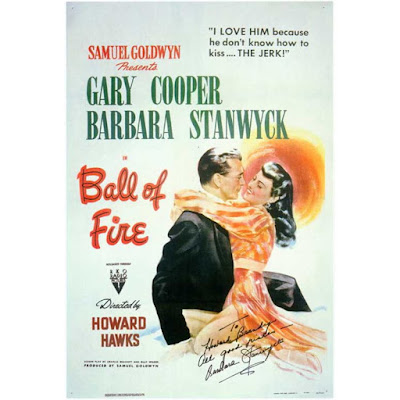There’s something about a patriotic holiday like 4th of July that makes me want to go back in time, at least when it comes to my movie-viewing. (It’s easy, on the day of our nation’s birth, to settle on the perfect audio choice: the classic—and still hilarious—1961 comedy album, Stan Freberg Presents The United States of America: The Early Years. But I digress.) This past weekend, when it came to picking a movie, I settled for a screwball comedy with a title that sounds like a fireworks display: 1941’s Ball of Fire. Frankly, this title has nothing to do with the story that unfolds onscreen. But it suggests a blaze of romantic fireworks, which this movie delivers in spades.
Ball of Fire has quite a pedigree. It was written by Charles Brackett and Billy Wilder, just before the latter decided it was time to start directing his own screenplays, resulting in such masterworks as Double Indemnity and The Lost Weekend. It was directed by Howard Hawks, coming off the sparkling His Girl Friday and the patriotic Sergeant York. On Sergeant York, the true-life story of a soft-spoken country boy who became a World War I hero, the leading role was played by Gary Cooper, who won an Oscar for his iconic strong-silent-type performance. In Ball of Fire, he would pivot to the comedic role of a naïve academic, Professor Bertram Potts. Also in 1941 the always-memorable Barbara Stanwyck was having a banner year, appearing in five films, including The Lady Eve and Meet John Doe, along with her sexy role as Sugarpuss O’Shea in Ball of Fire. With all this talent, plus a boat-load of memorable character actors like S.Z. Sakall and Oskar Homolka, the film proved to be a hit with both critics and the public. It was nominated for four Oscars (one for Stanwyck’s performance), and in 2016 was chosen for the National Film Registry.
So what’s this slight but very funny film all about? It’s part of a time-honored Hollywood genre in which a good-hearted but naïve young man is transformed through his interaction with a woman of the world. How curious! We know Hollywood (both then and now) to be a place where the sharks are predominantly male, and innocent young ladies proceed at their own risk. Still, viewers in the 1940s seemed to love movies (whether romantic comedy or film noir) in which the man is an innocent, someone who faces and succumbs to the dangers posed by a predatory dame. A comedy classic of this ilk is Preston Sturges’ The Lady Eve, in which it’s Henry Fonda, not Gary Cooper, who’s an unworldly academic falling prey to Stanwyck’s charms. The Lady Eve is a far more complicated movie than Ball of Fire, with a more ambiguous ending, and a film buff of my acquaintance vastly prefers it. Double Indemnity carries the same trope into darker territory, with patsy Fred MacMurray lured by Stanwyck (now a blonde bombshell) into a deadly scheme for which he’ll ultimately take the fall. Clearly Stanwyck is a lady who shouldn’t be trusted . . . but Ball of Fire also hints at her softer side.
It’s said that one of the major influences on Ball of Fire is Snow White and the Seven Dwarves. Cooper’s character, you see, is a grammarian who – along with seven crochety scholars from various fields – is working on a ground-breaking new encyclopedia. All unmarried, they live together in a big house, pursuing their arcane research. Then Sugarpuss shows up and teaches them to dance the conga—and hilarity ensues.








No comments:
Post a Comment